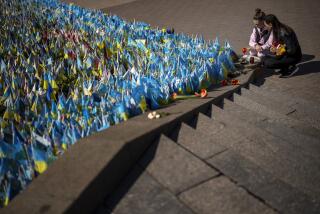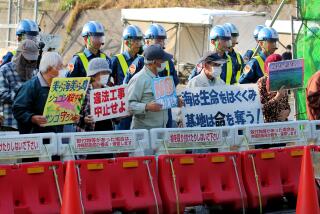Hurrying Up and Waiting for Their Marching Orders
FT. BRAGG, N.C. — The 40-millimeter grenade rounds were arcing downrange, one after another, a laughable “boink” announcing each lethal launch. The M-16s were firing steadily, “tat-tat-tat, tat-tat-tat,” in three-round bursts.
And Pfc. Kenneth Pullen was giving the imaginary enemy what-for with the big machine gun, the M-60, sending out 9.2 rounds per second: “chuka-chuka-chuka-chuka-chuka.”
But after the ammo ran down and the “Cease fire!” call worked its way along the ambush line, the practice session ended and the silence began. The soldiers of the Army’s 330th Movement Control Battalion had a moment to wonder and worry.
“We don’t know if we’re going somewhere, or when, or where, or anything. I’m a little nervous,” said Pullen, the tough machine-gunner who moments earlier was shouting, “I love my 60! I love this gun!”
“It’s weird, not knowing,” the 21-year-old private said late last week. “Do you know anything?”
It was the same question posed the night before by the stone-faced sentry with the locked and loaded M-16, tending an entrance to Ft. Bragg. The same question posed by the baby-faced sentry tending a different entrance the same recent morning. The same question, asked with hope, by paratroopers headed for a night jump out of nearby Pope Air Force Base: “Do you know anything?”
As at military posts across the country and around the world, soldiers and their families at Bragg, home to the 82nd Airborne and several commando units, find themselves in an atmosphere of limbo unlike any they’ve seen before.
While Pentagon planners work up scenarios about fighting a “war on terrorism,” and do so with intense secrecy, the soldiers here not only know nothing of what the near future might hold, they can’t even guess.
Do you think you’ll be deployed?
“No idea.”
If you are, where do you think you would go?
“You tell me. Seriously. Do you have any idea?”
Before the U.S. invasion of Panama in 1989, everyone here knew airborne troops would play a pivotal role. During the military buildup before the Persian Gulf War, it was immediately obvious that hundreds of mechanized units would deploy for a ground campaign because Saddam Hussein’s troops were dug in across the harsh deserts of Iraq and Kuwait.
“These guys train their whole lives to go to war to fight a known enemy,” said Sgt. 1st Class Jose Velasquez of the 18th Airborne Corps here. “Who’s the enemy? What is a war on terrorism? It’s kind of like a war on drugs, where you go after the dealers, the suppliers, you counsel kids about the dangers of using them, I guess. It’s very different.”
Indeed, other than accused terrorist mastermind Osama bin Laden and perhaps Afghanistan’s ruling Taliban, just who the enemy is in this new war remains as confusing to the troops as it does to civilians. But at this post, home to 46,000 soldiers, the question is perhaps more unnerving.
If the United States invades Afghanistan, would Pfc. Pullen’s 330th Movement Control Battalion, which protects and coordinates vehicle convoys, be deployed there?
What about the pilots of the A-10 Warthog tank-killers stationed at Pope? They were among the heroes of the Gulf War, coming in low and slow in their ugly, lumbering, but nearly indestructible planes, and battering the Soviet-made tanks so fiercely their turrets popped off.
The Taliban, though, has very few tanks.
The mystery of the new era--the pleas for patience from President Bush even though Delta Force and Special Forces commandos from here vanished two weeks ago and are now reportedly operating in Afghanistan--seems to weigh a bit less on the veterans than the newcomers.
“My parents have nonstop questions and I have no answers,” said Pfc. Erik Wernig, a 20-year-old Bostonian, as he pulled at his camouflage flak jacket, getting comfortable after an hour firing out of a foxhole. “I don’t know what to think.”
Cpl. Jenny Warram, a 21-year-old from Kansas City who works in a supply unit, isn’t sure what to think either. Standing with 90 pounds of parachutes, weaponry and gear--nearly as much as this wisp of a woman weighs--Warram said she earned her parachute wings mostly for the hazardous duty pay: $150 a month. She has a husband and a 7-month-old daughter, and would like to know what country she’ll be living in next week.
As always, wars, rumors of wars, and in this case rumors of rumors of wars, can be hardest on the soldiers’ families.
“When President Bush says, ‘Let’s go,’ that’s it, we go,” said Gulf War veteran Staff Sgt. Jeff Shuman, as he suited up down the line from Warram, preparing for a nighttime jump. “My wife, she’s a little nervous. Well, a lot nervous.”
So were his two boys, Greg, 10, and Jack, 6, who got to stay up an extra half an hour, as they always do when he jumps at night, because they’re too worried to sleep and do better playing games and watching reruns of “Leave It to Beaver.”
Shuman’s wife, Cindy, deals with her fears by assuming the worst, or almost the worst: that her husband is going to war. He went to the Middle East before and during the Gulf War. He served in Honduras and in the Sinai desert. And he was in a C-130 Hercules in 1995, suited up and on his way to invade Haiti, when then-President Clinton turned the planes around following last-minute negotiations.
“I don’t think the planes are going to turn around this time,” she said. “I just have to be strong. My husband can’t go away worrying that Cindy can’t handle it. I go to bed and I have my little pity parties by myself. But I’m OK. I’m OK.
“I just wish we knew something,” she continued. “Have you heard anything?”
More to Read
Sign up for Essential California
The most important California stories and recommendations in your inbox every morning.
You may occasionally receive promotional content from the Los Angeles Times.










